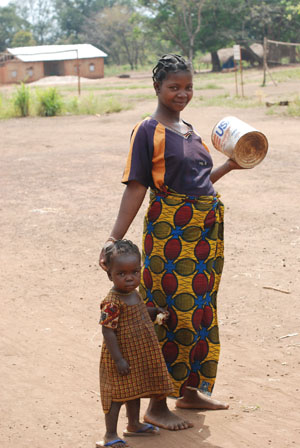
Along the remote border frontiers of Congo, the Central African Republic, or CAR, and South Sudan, an underreported yet highly devastating refugee crisis continues to unfold. Hundreds of thousands of people, having fled from the vicious, predatory violence of the Lord’s Resistance Army, or LRA, eke out a precarious existence as refugees and internally displaced people in an extremely underdeveloped region of the world. In keeping with the spirit of this past Wednesday’s World Refugee Day, originally established by the United Nations in 2001 to honor and remember persons uprooted from their homes as a result of violent conflict, Enough takes a moment to reflect on the plight and courage of these individuals.
The LRA, a Ugandan rebel group, plagued northern Uganda from 1986 until 2006, when the Ugandan People’s Defense Force, or UPDF, finally pushed them out into the Congo. Since then, the LRA has scattered across a region the size of Arizona at the juncture of Congo, CAR, and South Sudan, terrorizing local civilian populations with indiscriminate killings, mutilations, and —most notoriously—the abduction of children for service as soldiers or sex slaves. Although pursued by regional security forces, the LRA—moving in small groups—has managed to survive in the bush, making hit-and-run attacks on local communities.
Fearing for their lives, many inhabitants of this region have abandoned their homes and flocked to large population centers or other areas outside LRA reach. According to the United Nations High Commissioner for Refugees, up to 440,000 people have been forced to flee their homes because of LRA violence, 335,000 in the Congo alone. Some 22,000 people from CAR and Congo have become refugees in South Sudan, and just last year 7,382 South Sudanese were internally displaced. Already in 2012, over 4,000 Congolese have become newly displaced from a surge in LRA violence. For those displaced within regions of LRA activity, life can be extraordinarily difficult. It is unsafe to venture out from towns to farmland, and limited road access decreases the humanitarian aid that can reach the area.
Such widespread suffering and displacement is shocking; even more shocking is the means by which such suffering comes about—by the actions and reputations of only some 250-300 fighters. Horrific LRA atrocities have understandably inculcated widespread fear among the civilian population. So great is the fear of the LRA, notes U.S. State Department’s Field Representative for Lord’s Resistance Army Issues Jason Lewis-Berry, that mere rumors can push large groups to flee an area.
In October 2011, President Obama deployed approximately 100 military advisors to the LRA-affected region to aid local security forces in the pursuit of the LRA and the protection of civilian populations. However, LRA attacks continue as before, and people are still forced to flee their homes. Without significant alterations to the U.S. mission strategy and overall security conditions, including an increased focus on protection of civilians, the crisis will drag on, leaving untold numbers far from home.
Photo: Mother and daughter, Congolese refugees living in South Sudan, were displaced by LRA attacks in northeastern Congo (Enough / Laura Heaton)

